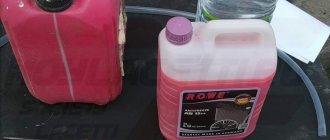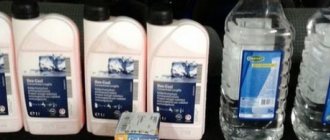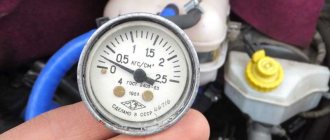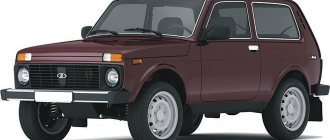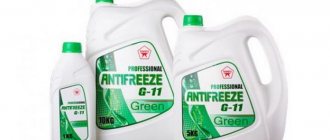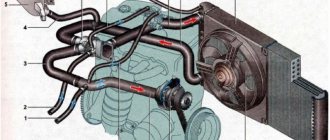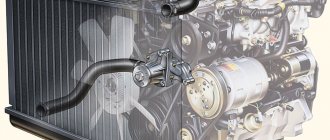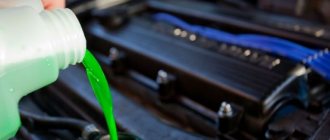In modern car power plants, only a liquid cooling system is used. It has become widespread due to the fact that it allows you to maintain optimal engine temperature in different operating modes and in all weather conditions. At the same time, reaching the required temperature regime occurs much faster due to the peculiarities of the operation of such a system.
Cooling system design features
The main working element of the water cooling system is a special liquid (antifreeze, antifreeze). All other structural parts only ensure its movement, redirection and removal of excessive heat. That is, the cooling jacket is just a system of specially made channels through which the liquid moves, washing the hottest elements. The pump included in the design ensures the movement of the liquid. The thermostat divides the entire system into two circles - small and large. At low temperatures, the liquid moves only inside the cooling jacket, which ensures a rapid increase in temperature and the motor reaching the required mode. With a large circle, the already heated liquid is sent through a radiator, the purpose of which is to ensure heat exchange with the environment. And since the cooling system is closed, it does this without direct contact with air.
The system also includes another radiator - a cabin radiator, which does the same as the main one, but at the same time it releases heat into the cabin. A closed system means that all the component elements are connected into one whole, and this is done using rubber pipes. Well, to control and force heat exchange, the design uses sensors and a fan driven by an electric motor, which is installed on the main radiator. This is the entire design of the cooling system.
Read more about the design and operation of the cooling system in this article.
Video: Replacing coolant: antifreeze or antifreeze on a VAZ 2110, 2114, 2115 injector
Radiator flushing
To flush the radiator, disconnect the upper, lower and all other hoses from it.
Insert the hose into the upper radiator inlet. Run a stream of clean water into the radiator and continue flushing until clean water comes out of the lower radiator outlet.
If after a reasonable amount of time there is no clear water coming out of the lower hose, you can flush the radiator with a good commercial cooling system flush cleaner. Follow the product manufacturer's instructions carefully. If the contamination is very severe, remove the radiator, insert a hose into the lower radiator outlet and backflush the radiator (counterflow).
Coolant fluid
And yet, its main element is liquid. Initially, ordinary water was used as it. But due to the high freezing temperature (at 0 degrees C the crystallization process already begins) it turned out to be impractical. After all, ice can destroy the integrity of the cooling jacket and tear the radiator pipes and pipes. Therefore, previously, in winter, drivers had to constantly drain the water when parking the car, and before leaving, refill it again, and warmed it up. In addition, water actively interacted with the structural elements of the power unit, causing corrosion and oxidation processes.
Nowadays, special liquids are used in the cooling system - antifreeze or antifreeze, which are free from the disadvantages of water. Anifriezes are the most widespread. They are produced in two types according to freezing temperature - regular (crystallizes at -45 degrees C) and arctic (freezes at -65 degrees C).
Antifreeze consists of ethylene glycol (nowadays, liquids including propylene glycol, which is not so toxic, are increasingly appearing) and distilled water. Moreover, this mixture must have certain proportions. Interestingly, an increased amount of ethylene glycol and distillate leads to an increase in freezing point.
Additionally, antifreeze includes a package of additives that perform a number of functions - it prevents the occurrence of corrosion processes and the harmful effects of liquid on rubber elements, prevents the liquid from foaming, etc.
But these additives also have a negative side. The fact is that different manufacturers use their own specific components of these additives. As a result, two different brands of antifreeze cannot be mixed, otherwise a conflict between additives may occur, which results in the formation of foam and sediment in the form of flakes that can simply clog small-section channels.
Find out which antifreeze is best for your car in this article.
Frequency of antifreeze replacement
At the same time, antifreeze has its own resource, after which it requires replacement. It's simple - over time, water accumulates in it, which increases the temperature threshold, and the additives stop working. In addition, the liquid is constantly moving, which means it washes the engine elements, so it gradually accumulates debris and dirt particles. The frequency of antifreeze replacement depends on its composition. If it is made on the basis of ethylene glycol, then it is recommended to change it after 3 years of using the car, and if propylene glycol is used in its composition, then after 5 years or 60,000 km.
The procedure for replacing coolant differs on different cars, since the design of the cooling system may differ. In this regard, the question often arises: where to pour antifreeze or antifreeze? For example, most cars use a sealed radiator, and the coolant is poured through a special expansion tank. But there are also cars in which replacing or adding antifreeze is done not through the tank, but through the radiator, which has a filler neck.
Therefore, let’s look at how to replace the coolant on cars with different cooling system designs. Note that this work is not difficult and even a beginner can easily do it.
Coolant selection
First, you need to figure out how much coolant is provided in the VAZ 2110. This will allow you to purchase the required amount of antifreeze and correctly carry out the replacement procedure.
We have already understood how much coolant is provided in the VAZ 2110, and how much needs to be filled. So it's time to choose.
In order to make a smart purchase of a new antifreeze, follow a few simple rules.
- Purchase a liquid with the same characteristics, color and production that was used previously. Of course, if the previous coolant worked effectively. Mixing different types of antifreeze is a common mistake that can lead to unpredictable consequences.
- Take a closer look at the packaging of the liquid you purchased. Today they sell both ready-to-fill formulations and concentrates, which must be diluted before use.
- Replace antifreeze only when the engine has completely cooled down.
- Start the engine after replacing the coolant strictly after all connections are made and the expansion tank cap is closed.
How to replace coolant using the example of a VAZ-2110
First, let's look at how the replacement is done on a VAZ-2110 car. This car uses a design that includes an expansion tank. Additionally, this model is interesting because it has a drain plug on the cylinder block, which is not found on all cars.
Video: Replacing the coolant. VAZ 2114
Tools you will need:
- a set of wrenches (open-end, spanner);
- container for collecting coolant;
- rags.
You should also stock up on the required amount of antifreeze. This information can be found in those. documentation for the vehicle, in the “refill tanks” section. You can also buy undiluted antifreeze, but its concentrate. But here you will additionally need a distillate and knowledge of the proportions to properly mix the solution.
So, having everything, you can start replacing, which is done like this:
- We place the VAZ-2110 on a flat surface, immobilize it and remove the terminal from the battery to prevent accidental shorting of the wiring contacts.
- First, the liquid is drained from the cylinder block, the drain plug of which is located on the right side (if you are in front of the car) under the ignition module.
- We remove the ignition module from the car, for which we disconnect from it the high voltage wires going to the spark plugs and the block with regular wires. We unscrew the three bolts securing the module and remove it, then remove the cover from the expansion tank.
- Below this module there will be a plug, which is a regular 13mm bolt. Before unscrewing it, place a collection container under the car (a good option is a 5 liter plastic canister with a cut out side). We unscrew the plug and wait for the coolant to drain from the block. As soon as it stops leaking, replace the plug and tighten it. We wipe the engine with a rag to remove any antifreeze stains. We put the module in place and connect it.
- We look for a bolt with a wing head on the radiator at the bottom - this is the radiator plug. It is installed at the bottom left. Place a container under it and unscrew it. If you can’t do it with your hands, you can use a regular open-end wrench size 17. Drain the coolant from the radiator completely and replace the plug.
- Let's start filling in new antifreeze. To do this, gradually, in several passes, pour antifreeze into the tank. He will go away slowly. It is important to ensure that the antifreeze level in the tank is at “Max” after the system is filled.
- We start the engine and monitor the level. It is necessary to ensure that the motor reaches the optimal temperature regime, after which the thermostat will open and release liquid in a large circle. At the same time, the coolant in the tank will begin to quickly leave. After this, we bring the level to “Max” and put the tank cap in place. The coolant has been replaced.
Why and when does it need to be changed?
At first, engine overheating leads to an increase in fuel consumption, then to a decrease in engine power.
Low-quality antifreeze that does not fulfill its functions of cooling the engine poses a clear threat to the heart of the car. Overheating threatens cracks in the cylinder head, burnout of pistons, engine wedge and many other consequences, the cost of repairing which will cost the car owner a tidy sum.
Modern engine cooling fluids have fairly large stated operating standards, often reaching hundreds of thousands of kilometers. However, real conditions often make adjustments. Therefore, already 60–70 thousand km after filling the antifreeze, it is advisable to replace it. Cheap brands have even less operating mileage - 30-40 thousand km. The manufacturer also sets time limits for using antifreeze. Depending on the brand of liquid, they can range from 2 to 5 years.
However, you cannot rely only on the service life declared by the manufacturer. First of all, you need to pay attention to how the engine behaves. If the operating temperature of the engine is constantly dangerously close to the red zone, then this is the basis for checking the engine cooling system. It is possible that antifreeze is to blame for this behavior of the engine.
You will have to add new coolant even when its external signs change. High-quality antifreeze is a transparent liquid, the color of which does not change during operation. Turbidity or, conversely, discoloration may indicate that the performance characteristics of the liquid have decreased. Other changes visible to the eye also indicate this: the presence of foam, sediment, flakes or scale is an unambiguous “sentence” on the old antifreeze.
How to replace antifreeze using the example of Toyota RAV4
Let's move on to cars in which coolant is filled through the radiator. For example, such a car is the Toyota RAV4. In general, many Japanese cars are distinguished by this design.
Video: Replacing coolant on Toyota Corsa
In many ways, the replacement work is identical to that described. That is, first we remove the plugs from the radiator and expansion tank, then we drain the liquid through a tap or drain plug installed on the radiator, then we close this tap.
Remember that the fluid circulates in the system under pressure and you need to let the engine cool before unscrewing the radiator cap.
We remove the expansion tank, wash it, and put it in place. Then you need to drain the remaining fluid from the cylinder block by unscrewing the bolt. You can also drain the remaining antifreeze from the radiator heater.
Then check that all bolts and plugs are tightened in place. All that remains is to pour antifreeze into the radiator up to the neck, start the engine and let it run, bringing the antifreeze to the level. Then fill the expansion tank with antifreeze to the “Min” level.
Many people flush the system at the same time. It is not difficult to make, since this process is done with distillate. After draining the old coolant, distilled water is poured in, then it is passed through the system, poured out, and new antifreeze is poured in.
Air removal methods
If you observe on the dashboard that the operating temperature of the engine is constantly exceeded (100 degrees or more), follow a number of steps to identify the problem:
- examine the joints of the pipes, the water pump and the expansion tank for leaks;
- check the fluid level in the tank;
- make sure that the cabin heater is functioning properly;
- If the temperature sensor is installed outside the cylinder head, check the operation of the electric fan by closing the contacts.
